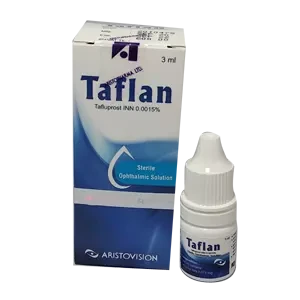Taflan Uses, Dosage, Side Effects and more
Taflan, a prostaglandin analog is a selective FP prostanoid receptor agonist which is believed to reduce intraocular pressure by increasing uveoscleral outflow of aqueous humor.
Taflan is a novel prostaglandin analog with a high affinity for the fluoroprostaglandin (FP) receptor PGF2α. Taflan has an affinity for the FP receptor that is approximately 12 times higher than that of the carboxylic acid of latanoprost, but with almost no potential to bind to other receptors.

| Attribute | Details |
|---|---|
| Trade Name | Taflan |
| Generic | Tafluprost |
| Tafluprost Other Names | Tafluprost |
| Weight | 015% |
| Type | Eye Drops |
| Formula | C25H34F2O5 |
| Weight | Average: 452.5313 Monoisotopic: 452.237430608 |
| Groups | Approved |
| Therapeutic Class | Drugs for miotics and glaucoma |
| Manufacturer | Aristopharma Ltd |
| Available Country | Bangladesh |
| Last Updated: | January 7, 2025 at 1:49 am |
Uses
Taflan is used for reducing elevated intraocular pressure in patients with open-angle glaucoma or ocular hypertension.
Taflan is also used to associated treatment for these conditions: Increased Intra Ocular Pressure (IOP), Ocular Hypertension
How Taflan works
Taflan acid is a prostanoid selective FP receptor agonist that is believed to reduce the intraocular pressure (IOP) by increasing the outflow of aqueous humor. Studies in animals and humans suggest that the main mechanism of action is increased uveoscleral outflow.
Dosage
Instill one drop in the affected eye(s) once daily in the evening.
How Long Does It Take to Work?
How Long Does It Take to Work? see here Taflan
Side Effects
The most frequently reported treatment-related side effect is ocular hyperemia. Rare side effects observed include eye irritation and blurred vision.
Toxicity
Most common ocular adverse reaction is conjunctival hyperemia (range 4% – 20%).
Precaution
- For ophthalmic use only.
- To avoid possible contamination of the drops, do not touch the dropper tip or to any surface.
- Should be used with caution in patients with active intraocular inflammation (e.g., iritis/uveitis).
- If more than one topical ophthalmic drug is being used, the drugs should be administered at least five (5) minutes between applications.
Food Interaction
No interactions found.Volume of Distribution
The highest concentration of tafluprost acid was found in the cornea and conjunctiva.
Elimination Route
Following instillation, tafluprost is absorbed through the cornea and is hydrolyzed to the biologically active acid metabolite, tafluprost acid. Taflan is an ester which makes the drug lipophillic enough to be quickly absorbed through. When administered to the eye, the peak plasma concentration (Cmax) and time to peak plasma concentration (Tmax) of tafluprost acid in healthy subjects was 26 pg/mL and 10 minutes respectively. a AUC, tafluprost acid = 394 pgmin/mL - 432 pgmin/mL.
Elimination Route
Mean plasma tafluprost acid concentrations were below the limit of quantification of the bioanalytical assay (10 pg/mL) at 30 minutes following topical ocular administration of tafluprost 0.0015% ophthalmic solution. In male rats, it was observed that tafluprost was excreted into the feces.
Pregnancy & Breastfeeding use
Use in pregnancy: Pregnancy category C. There are no adequate and well-controlled studies in pregnant women. Taflan ophthalmic solution should be used during pregnancy unless the potential benefit justifies the potential risk to the fetus.
Use in lactation: It is not known whether Taflan is excreted in human milk. Caution should be exercised while giving this ophthalmic solution to a nursing mother.
Contraindication
Taflan ophthalmic solution is contraindicated in patients who are hypersensitive to any component of this product.
Special Warning
Use in children: Use in pediatric patients is not recommended.
Use in elderly patients: No overall differences in safety and effectiveness have been observed between elderly and other adult patients.
Innovators Monograph
Taflan contains Tafluprost see full prescribing information from innovator Monograph, MSDS, FDA label
FAQ
What is Taflan used for?
Taflan ophthalmic is used to treat glaucoma (a condition in which increased pressure in the eye can lead to gradual loss of vision) and ocular hypertension (a condition which causes increased pressure in the eye).
What are the side effects of Taflan eye drops?
Side Effects:
- Blurred vision.
- burning, dry, or itching eyes.
- decreased vision.
- eye discharge or excessive tearing.
- eye pain.
- redness, pain, or swelling of the eye, eyelid, or inner lining of the eyelid.
How Taflan works?
Taflan is in a class of medications called prostaglandin analogs.Taflan works lowers pressure in the eye by increasing the flow of natural eye fluids out of the eye.It is in a class of medications called prostaglandin analogs.
Is safe Taflan during pregnancy?
This drug should be used during pregnancy only if the benefit outweighs the risk to the fetus.
Is Taflan safe during breasfeeding?
Taflan is not likely to reach the breastmilk or bloodstream of the infant or to cause any adverse effects in breastfed infants. Professional guidelines consider prostaglandin eye drops acceptable during breastfeeding.
How do you use Taflan?
Taflan is usually instilled in the affected eye(s) once a day in the evening. Use Taflan at around the same time in the evening every day.
What are the indications of Taflan?
Certain medicines should not be used at or around the time of eating food or eating certain types of food since interactions may occur. Using alcohol or tobacco with certain medicines may also cause interactions to occur.
How can I use of Taflan?
Your eye doctor will tell you how much of Taflan to use and how often. Do not use more medicine or use it more often than your doctor tells you to.
How long does it take Taflan to work?
Taflan takes about 2 to 4 hours to kick in and 12 hours to reach maximum effect.
Should Taflan be refrigerated?
After opening the foil pouch, refrigeration is not required.
Does Taflan make eyelashes grow?
Taflan can make you grow more eyelashes or cause your current eyelashes to become longer and thicker.



